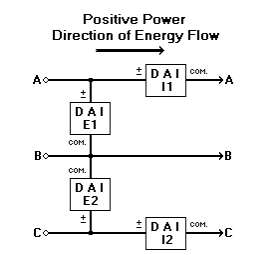Lab 1: Info
ECE330 - Introduction to Power Engineering
Electrical and Computer Engineering - University of Alberta
1 Technical Information about the Electrical and Mechanical Power Functions
There are a number of different electrical and mechanical power functions available for power meters. The following list gives an example for each different type of electrical and mechanical power functions:
PQS1 (E1,I1)
PQS1+PQS2
PQS1 (E1,I1) 3~
Pm (T,N)
The simple electrical power functions (PQS1 (E1,I1), PQS2 (E2,I2), etc.) measure the value of the power from a single voltage input and a single current input (E1, I1, for example) of the Data Acquisition and Control Interface (DACI) module. Electrical power functions measure active power (P), reactive power (Q) or apparent power (S), depending on the operating mode selected on the meter.
The electrical power summing functions (PQS1+PQS2, PQS1+PQS2+PQS3, etc.) sum active (P), reactive (Q) or apparent (S) power of two or more power meters, depending on the operating mode selected on the meter. Active power sums are obtained by calculating the algebraic sum of the active powers. Similarly, reactive power sums are obtained by calculating the algebraic sum of the reactive powers. Apparent power sums are obtained by calculating the vectorial sum of the active and reactive power sums. Note that the PQS1+PQS2 power summing function can be used to measure three-phase power using the two-wattmeter method, when inputs E1, E2, I1,and I2 of the Data Acquisition and Control Interface (DACI) module are connected as shown in the following figure. Capture.PNG

2 Wattmeter Method
The three-phase electrical power functions (PQS1 (E1,I1) 3~, PQS2 (E2,I2) 3~, etc.) measure three-phase power using the line-to-line voltage and line current indicated in parentheses. Active power (P), reactive power (Q) or apparent power (S) is measured depending on the operating mode selected on the meter. Three-phase power is calculated in three steps. The line-to-line voltage is phase shifted by 30 degrees and divided by the root square of 3 to determine the corresponding line-to-neutral voltage. Single-phase power is then calculated using the line-to-neutral voltage and the line current. Finally, three-phase power is obtained by multiplying the single-phase power by 3. Note that accurate three-phase power measurements are obtained as long as the system is balanced.
For more information on how electrical and mechanical power functions calculate active, reactive, and apparent power, see Technical Information about the Voltmeters and Ammeters.
The mechanical power function Pm (T, N) is identical to the function of mechanical power meter Pm. See Technical Information about the Mechanical Power Meter for additional information.